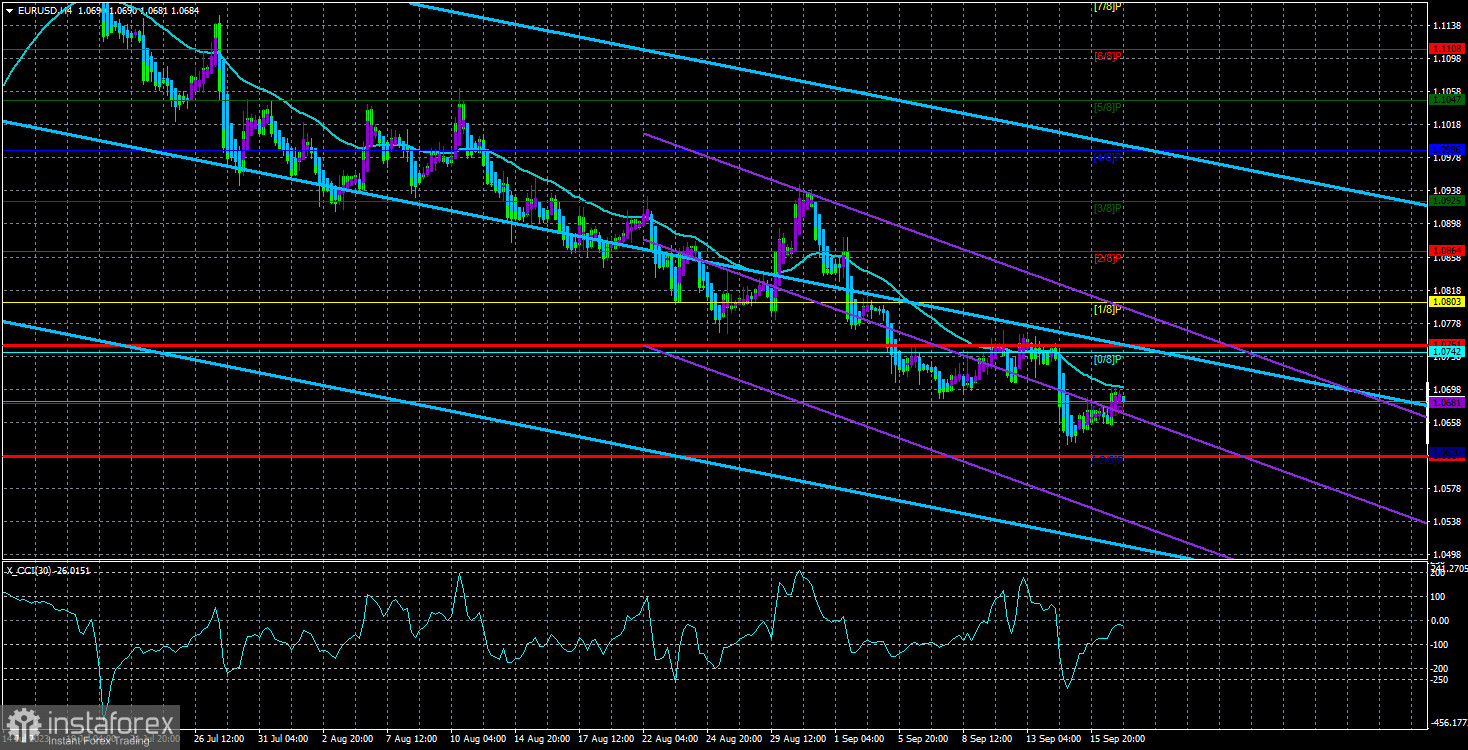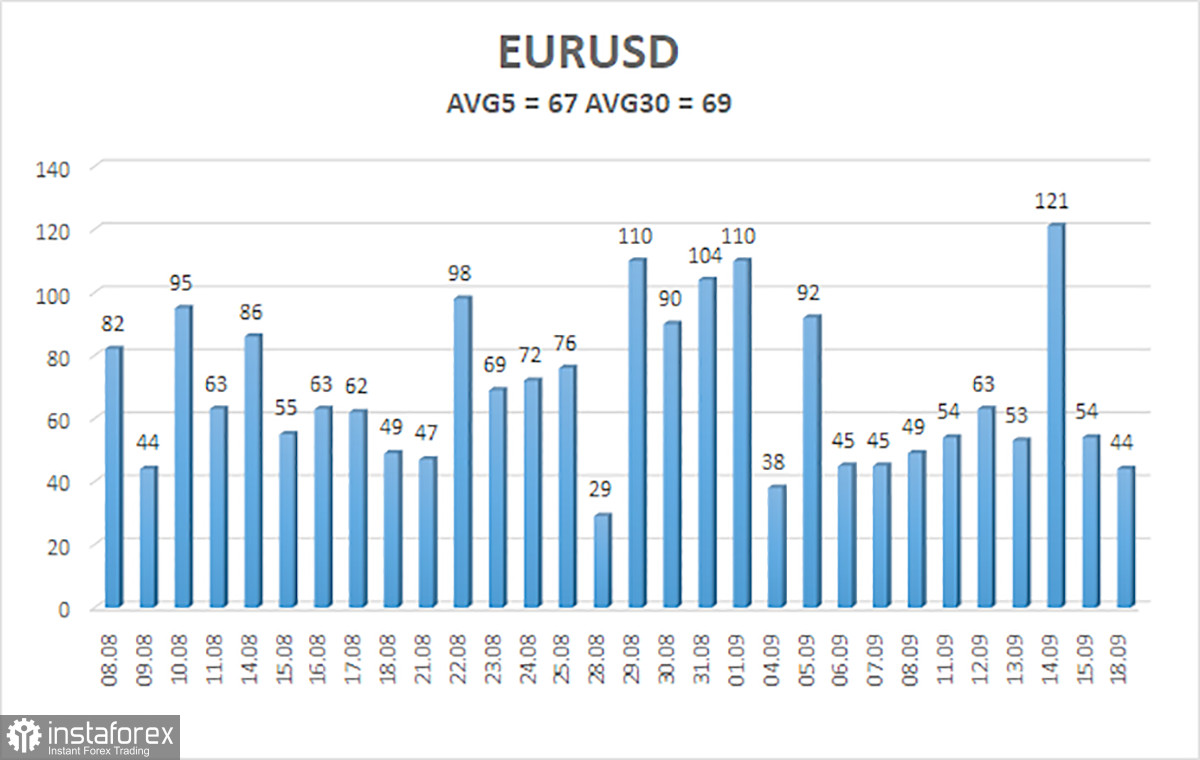
The EUR/USD currency pair continued its upward retracement on Monday, which had started on Friday. There were no significant publications or events in the United States, the EU, or Germany on either Friday or yesterday. Therefore, the European currency climbed by 50 points in two days but failed to sustain its position above the moving average line. As a reminder (visible in the illustration above), the CCI indicator entered the oversold area for the second time last week. Such signals are relatively rare, and if the trending movement is strong, up to three signals in the same direction can be generated before the actual movement begins. Currently, we see a need for more movement. Therefore, this week, the Euro can only be influenced by a strong fundamental background expressed only through the FOMC meeting.
What can we expect from the FOMC? Despite two consecutive inflation accelerations, the probability of a key rate hike in September is approaching zero. Undoubtedly, the Federal Reserve can decide to raise the rate, which would surprise the market. However, we believe the American regulator will wait until November to tighten its policy, adhering to the "1 hike/2 meetings" scheme. Consequently, there should be a few reasons to buy the US dollar tomorrow evening, but the accompanying FOMC statement and Jerome Powell's speech will also be significant. They cannot be predicted in advance, so speculating where the currency pair will end up by the end of the week is also meaningless.
The medium-term downward trend should persist in any case, regardless of the fundamental background. However, in the short term, an upward correction is possible. To achieve this, the price needs to establish itself above the moving average, but even that poses serious problems.
There still needs to be a consensus in the ECB.
The ECB's September meeting became one of the most contradictory in recent years. The market expected a pause, but the ECB raised rates for the tenth consecutive time. Despite another tightening of monetary policy, the European currency fell. Inside the monetary committee, there is discord because there is no consensus on what to do with rates going forward. Inflation in the EU is still far from the target level, so logically, further tightening should continue. However, historically, the ECB has not pushed rates to unprecedented heights. In Europe, they don't want to trigger a recession and a significant drop in GDP, only to stimulate the economy for years afterward. Therefore, it's likely that the decision was made that slightly higher-than-target inflation is acceptable, and inflation above the target for a little longer than planned is also acceptable.
In this case, there is no need to raise the rate further, as practically openly stated by Luis de Guindos, Vice President of the ECB, on Friday and Monday. On Friday, he announced that the regulator plans to wait to raise rates and keep them at the maximum level for an extended period. On Monday, he stated that the worst of the inflation is behind us, but uncertainty still lingers, as do increased risks. In simple terms, the ECB has indicated that further tightening will only be possible in the case of force majeure.
By the way, Peter Kazimir and Bostjan Vasle stated on Monday that raising the key rate must be considered open. Mr. Kazimir also noted that discussions on adjusting the PEPP and APP programs, representing "quantitative tightening," should begin soon. In other words, money is withdrawn from the economy through these programs to cool it down and reduce inflation, filling the markets with bonds and other securities. QT is the reverse of QE. Bostjan Vasle also pointed out that the "door is not closed," and rates could still rise under certain circumstances. However, the market has already entirely shifted its focus to the end of the "hawkish" course, so the Euro can continue to decline calmly.

The average volatility of the EUR/USD currency pair over the last five trading days as of September 19th was 67 points, characterized as "average." Therefore, we expect the pair to move between the levels of 1.0617 and 1.0751 on Tuesday. A downward reversal of the Heiken Ashi indicator will indicate a possible resumption of the downward movement.
The nearest support levels:
S1 - 1.0620
The nearest resistance levels:
R1 - 1.0681
R2 - 1.0742
R3 - 1.0803
Trading recommendations:
The EUR/USD pair continues its confident southward movement. It is advisable to remain in short positions with a target of 1.0620 until the price consolidates above the moving average. Long positions can be considered if the price consolidates above the moving average line, with targets at 1.0751 and 1.0803.
Explanation of the illustrations:
Linear regression channels - help determine the current trend. If both point in the same direction, it indicates a strong current trend.
The moving average line (settings 20.0, smoothed) - determines the short-term trend and the direction in which trading should be conducted.
Murray levels - target levels for movements and corrections.
Volatility levels (red lines) - the probable price channel the pair will trade over the next day, based on current volatility indicators.
CCI indicator - its entry into the overbought area (above +250) or oversold area (below -250) indicates an upcoming trend reversal in the opposite direction.
 English
English 
 Русский
Русский Bahasa Indonesia
Bahasa Indonesia Bahasa Malay
Bahasa Malay ไทย
ไทย Español
Español Deutsch
Deutsch Български
Български Français
Français Tiếng Việt
Tiếng Việt 中文
中文 বাংলা
বাংলা हिन्दी
हिन्दी Čeština
Čeština Українська
Українська Română
Română

